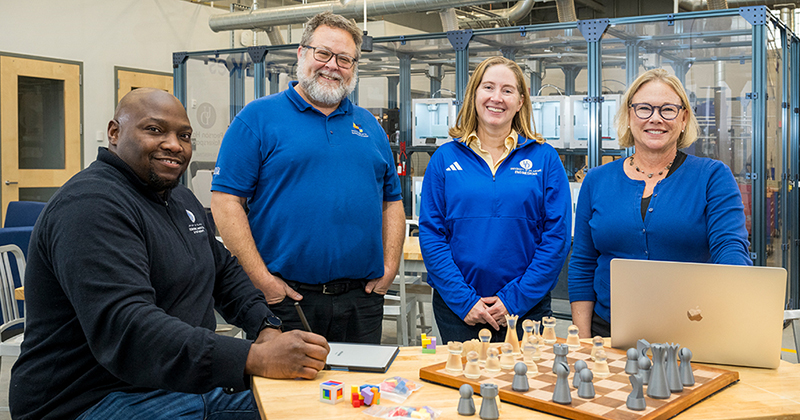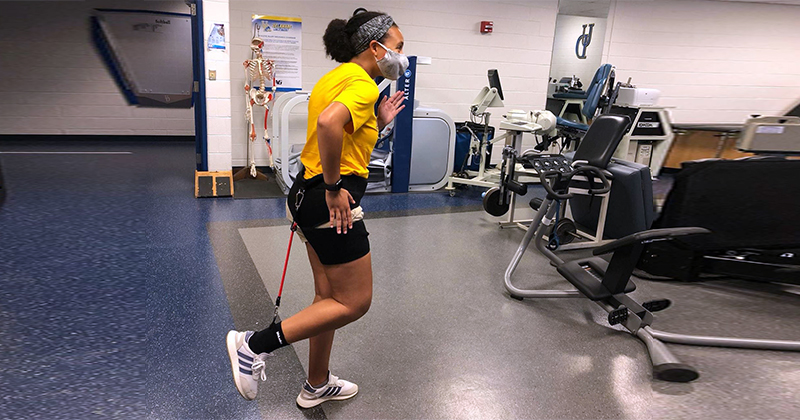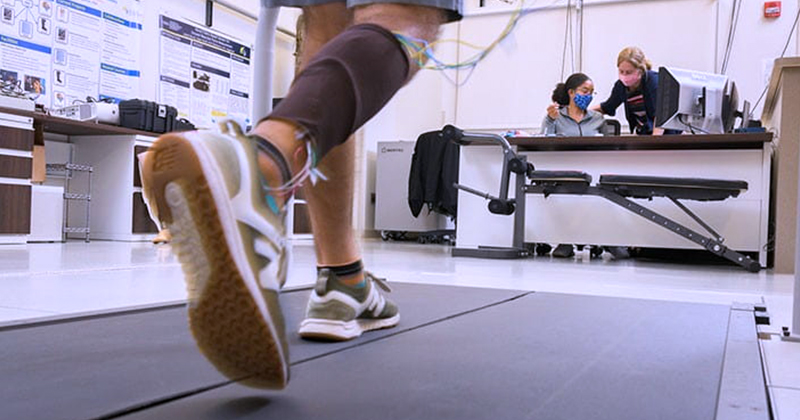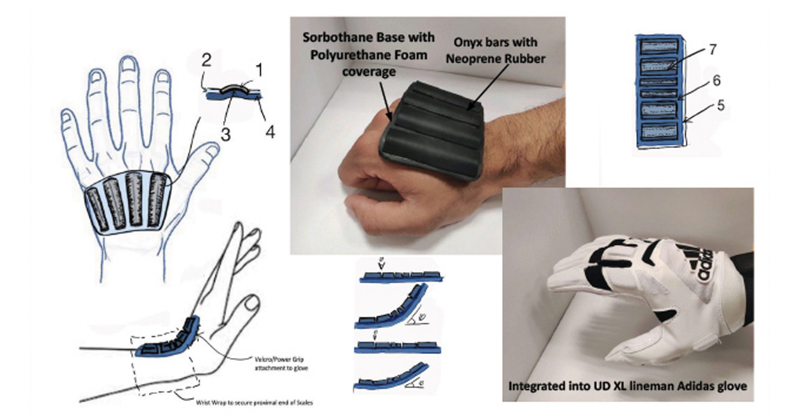


Accelerating translational research
Photos by Evan Krape and Kathy F. Atkinson February 21, 2024
UD receives $6 million from National Science Foundation as part of inaugural translational research funding program
From touch recognition and sensing that allows us to type messages on smartphones to carbon nanotube-based sensors that can track changes in our movement, the University of Delaware produces world-class ideas as one of the country’s top universities for research activity.
But it takes more than a great idea to make an impact — researchers also need institutional infrastructure, support staff and entrepreneurial skills in order to find the most effective way to bring their great ideas and technologies to life.
Now, UD will be empowered to increase the speed and scale of its translational research as a member of the inaugural cohort of 18 institutions supported by the U.S. National Science Foundation’s (NSF) Accelerating Research Translation (ART) program.
"NSF endeavors to empower academic institutions to build the pathways and structures needed to speed and scale their research into products and services that benefit the nation," said NSF Director Sethuraman Panchanathan. "The Accelerating Research Translation program in NSF’s new Technology, Innovation and Partnerships (TIP) Directorate identifies, and champions institutions positioned to expand their research translation capacity by investing in activities essential to move results to practice."
This effort will be led by PI Jill Higginson, George W. Laird Professor of Mechanical Engineering in UD’s College of Engineering and director of UD’s Institute of Engineering Driven Health (IEDH). Co-PIs include Julius Korley, associate vice president of UD’s Office of Economic Innovation and Partnerships (OEIP) and co-director of the NSF I-Corps Hub: Northeast Region, Tracy Shickel, associate vice president of corporate engagement, and Dan Freeman, associate professor of marketing in the Alfred Lerner College of Business and Economics and director of Horn Entrepreneurship.

“This is an incredible opportunity for UD to continue strengthening its institutional infrastructure to ensure that more of our bold ideas and exciting discoveries can have a positive impact on the world far beyond our campus,” said UD President Dennis Assanis. “Not only does this NSF ART program support a key strategic priority for the University; it’s also a testament to UD’s status as a regional and national leader in high-quality research, education and innovation.”
Through this ART cooperative agreement, UD will receive $6 million over four years to further develop its academic program offerings and administrative infrastructure while continuing to foster an institutional culture that values and embraces innovation and entrepreneurship.
“UD is a great place for interdisciplinary research thanks to our community of faculty, students and staff who have a willingness and awareness of the importance of work that reaches across disciplines, departments and colleges,” Higginson said. “Now, with the support of this cooperative agreement, we are excited to show that UD is open for business and that our prospective partners will be able to work with a high-tech, high-capacity, world-class group of individuals.”
To help increase the translation of fundamental research and enhance the University’s role as a regional innovation hub, the ART will allow UD to strengthen its institutional capacity for translational research, educate a new cohort of entrepreneurially-minded trainees, and create a cohort of ART ambassadors — a group of researchers who are knowledgeable about the research translation process and can teach and inspire others across campus.
“As an institution, we're prioritizing innovation and entrepreneurship, so with this ART we’re looking at capacity-building activities,” said Shickel, referring to one of the pillars of UD’s strategic plan. “We’ve done a lot of work looking at our practices, what's important to the institution, and then putting resources, teams and shared goals in place to facilitate those desired outcomes, all aligned with UD’s strategic plan.”
Much of the institutional capacity building efforts will take place in OEIP, with a focus on recruiting staff in crucial technology transfer positions, including a tech transfer associate dedicated to managing new ventures, along with some key office restructuring. Korley, who has been in his role at UD since the spring of 2022, is excited for the ability to bring UD's strategic vision for OEIP to life much more quickly thanks to this ART cooperative agreement.

“The NSF ART gives us the opportunity to expand OEIP while providing even better service to our faculty, staff and students,” Korley said. “With a larger and more specialized team, we’ll be able to do more outreach to our faculty while also providing more business intelligence capabilities. That way, when a researcher is trying to start a company, we can strategize with them on the best path forward.”
As part of the NSF ART program, each institution also receives mentorship from an institution of higher education that already has a robust ecosystem for translational research. Thanks to this new cooperative agreement, OEIP will be working closely with the technology transfer office at Princeton, a team Korley knows well from serving on their Dean for Research advisory council, as OEIP will now be enabled to evaluate different strategies that have worked at Princeton.
The NSF ART cooperative agreement also supports the development of new and ongoing trainee programs for post-docs in partnership with Horn Entrepreneurship, which celebrated its ten-year anniversary last year.
“Building a robust, supportive ecosystem for successfully translating research from lab to market takes time,” Freeman said. “ART will enable us to put the final pieces, including a comprehensive, on-demand training program for graduate students, post-docs and faculty, in place at UD.”
All of these efforts will enhance research translation within IEDH, which will serve as the “test platform” for determining best practices for tech transfer resources, industry partnerships, and connecting with commercialization experts. And while the initial focus will be around health-related technologies and devices, the long-term goal is to develop procedures and processes that can help accelerate entrepreneurship and commercialization for everyone at UD, said Higginson.

“One of the reasons I got into this kind of work was for a different definition of impact — for the ability to translate my work beyond my own research lab,” Higginson added. “Through this NSF ART, we want to foster a culture of innovation here at UD, to make it so that anyone who wants to engage in entrepreneurial activities can access knowledgeable mentors and useful resources to identify the best path forward.”
For Korley, success over the next four years of the cooperative agreement means increasing the number of UD-based start-ups, getting additional faculty engagement, and building up institutional capacity that then becomes self-sustaining.
“Once the ART is completed, our hope is that we can show how well our model works and how that’s led to enhanced commercialization opportunities for all of our faculty and staff. At that point, we’ll then be able to serve as a mentor to other institutions,” he said.
Shickel added that she hopes this NSF ART can help UD in “developing a culture of yes and how” for faculty who want to translate their research.
“Once you get to a point where translating research is effortless, it’s a virtuous cycle: We attract the best and brightest faculty and students, we have economic impact in the state, the region, the country, and that societal impact enhances our reputation even further,” she said. “We’ve identified some gaps, and now the NSF ART will enable us to address a lot of those gaps so we can accelerate our impact.”
Contact Us
Have a UDaily story idea?
Contact us at ocm@udel.edu
Members of the press
Contact us at 302-831-NEWS or visit the Media Relations website

